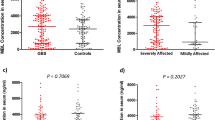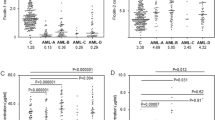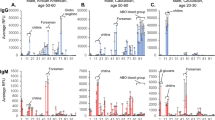Abstract
Human mannose binding protein (MBP) is a C–type serum lectin involved in first–line host defense against a variety of bacterial, fungal and viral pathogens. Recently an association was found between low levels of serum MBP and an increased frequency of recurrent infections in infants. A particular genotype, in which glycine is substituted by aspartic acid at codon 54 of MBP in the fifth collagen repeat, shows apparent concordance with the clinical phenotype. We report, however, that this genotype occurs in 5% of the population and encodes a functional protein. Our results indicate that the Gly54Asp allele does not account for a deficiency state, but instead suggest that MBP may have two predominant allelic forms that have overlapping function and differ only in their ability to activate the classical pathway of complement.
This is a preview of subscription content, access via your institution
Access options
Subscribe to this journal
Receive 12 print issues and online access
$209.00 per year
only $17.42 per issue
Buy this article
- Purchase on Springer Link
- Instant access to full article PDF
Prices may be subject to local taxes which are calculated during checkout
Similar content being viewed by others
References
Super, M. et al. Association of low levels of mannan-binding protein with a common defect of opsonization. Lancet (ii), 1236–1238 (1989).
Ezekowitz, R.A.B. Ante-antibody immunity. Curr. Biol. 1, 60–62 (1991).
Ezekowitz, R.A.B., Day, L. & Herman, G. A human mannose-binding protein is an acute phase reactant that shares sequence homology with other vertebrate lectins. J. exp. Med. 167, 1034–1046 (1988).
Kozutsumi, Y., Kawasaki, T. & Yamashina, I. Isolation and characterization of a mannan-binding protein from rabbit serum. Biochem. biophys. Res. Commun. 95, 658–664 (1980).
Mizuno, T., Kozutsumi, Y., Kawasaki, T. & Yamashina, I. Isolation and characterization of a mannose-binding protein from rat liver. J. biol. Chem. 256, 4247–4256 (1981).
Kawasaki, N., Kawasaki, T. & Yamashura, I. Isolation and characterization of a mannose-binding protein from human serum. J. Biochem. 94, 937–947 (1983).
Lu, J.H., Thiel, S., Wiedmann, H., Timpl, R. & Reid, K.B. Binding of the pentamer/hexamer forms of mannan-binding protein to zymosan activates the proenzyme C1r2C1s2 complex of the classical pathway of complement without involvement of C1q. J. Immunol. 144, 2287–2294 (1990).
Drickamer, K. Two distinct classes of carbohydrate-recognition domains in animal lectins. J. biol. Chem. 263, 9557–9560 (1988).
Kawasaki, T., Etoh, R. & Yamashura, I. Isolation and characterization of a mannose-binding protein from rabbit liver. Biochem. biophys. Res. Commun. 81, 1018–1024 (1978).
Kuhlman, M., Joiner, K. & Ezekowitz, R.A.B. The human mannose-binding protein functions as an opsonin. J. exp. Med. 169, 1733–1745 (1989).
Ezekowitz, R.A.B., Kuhlman, M., Groopman, J. & Byrn, R. A human serum mannose-binding protein inhibits in vitro infection by the human immunodefiency virus. J. exp. Med. 169, 185–196 (1989).
Janeway, C.A. Approaching the Asymptote: Evolution and Revolution in Immunology 1–13 (Cold Spring Harbor Symp. Quant. Biol., 1989).
Schweinle, J., Ezekowitz, R.A.B., Tenner, A. & Joiner, K. Human mannose-binding protein activates the alternative complement pathway and enhances serum bactericidal activity on a mannose-rich isolate of Salmonella. J. clin. Invest. 84, 1821–1829 (1989).
Ohta, M., Okada, M., Yamashina, I. & Kawasaki, T. The mechanisms of carbohydrate-mediated complemxent activation by the serum mannose-binding protein. J. biol. Chem. 265, 1980–1984 (1990).
Ikeda, K., Sannoh, T., Kawasaki, N., Kawasaki, T. & Yamashina, I. Serum lectin with known structure activates complement through the classical pathway. J. biol. Chem. 262, 7451 (1987).
Hammarstrom, L., Lefranc, G., Lefranc, M.P., Perrson, M.A.A. & Smith, C.E.I. in Immunoglobulin Subclass Deficiencies (eds Hanson, L.A., Soderstrom, T. & Oxelius, V-A.) 50–56 (Karger, Basel, 1986).
Sumiya, M. et al. Molecular basis of opsonic defect in immunodeficient children. Lancet 337, 1569–1570 (1991).
Higuchi, R. Amplifications 2, 1 (1989).
Gillies, S.D. et al. 1989 Expression of human anti-tetanus toxoid antbody in transfected murine myeloma cells. BioTechnology 7, 799–804 (1989).
Laemlli, N.K. Cleavage of structural proteins during the assembly of the head of bacteriophage T4. Nature 227, 680–685 (1970).
Super, M., Levinsky, R.J. & Turner, M.W. The level of mannan-binding protein regulates the binding of complement-derived opsonins to mannan and zymosan at low serum concentrations. Clin. exp. Immunol. 79, 144–150 (1990).
Shyur, S-D. & Hill, H.R. Immunodeficiency in the 1990s. Pediatr. infect. Dis. J. 10, 595–611 (1991).
Jacenko, O., Olsen, B.R. & LuValle, P. Organization and Regulation of Collagen Genes. Crit. Rev. Eukaryotic Gene Expression 1, 327–353 (1991).
Reid, K.B. Molecular cloning and characterization of the complementary DNA and gene coding for the B-chain of subcomponent C1q of the human complement system. Biochem. J. 231, 729–735 (1985).
Benson, B. et al. Structure of canine pulmonary surfactant apoprotein: cDNA and complete amino acid sequence. Proc. Natn Acad. Sci. U.S.A. 82, 6379–6383 (1985).
Floras, J. et al. Isolation and characterization of cDNA clones for the 35-kDa pulmonary surfactant-associated protein. J. biol. Chem. 261, 9029–9033.
Malhotra, R., Thiel, S., Reid, K.B.M. & Sim, R. Human leukocyte C1q receptor binds other soluble proteins with collagen domains. J. exp. Med. 172, 955–959 (1990).
Childs, R.A., Feizi, T., Yuen, C.T., Drickamer, K. & Queenberry, M.S. Differential recognition of core and terminal portions of oligosaccharide ligands by carbohydrate recognition domains of two mannose-binding proteins. J. biol. Chem. 265, 20770–20777 (1990).
Weis, I.W.R., Kahn, R., Foume, K., Drickamer & Henrickson, W.A. Structure of the calcium-dependent lectin domain from a rat mannose-binding protein determined by MAD phasing. Science 254, 1608–1615 (1991).
Ezekowitz, R.A.B. Antigens coming to a sticky end. Curr. Biol. 2, 147–149 (1992).
Author information
Authors and Affiliations
Rights and permissions
About this article
Cite this article
Super, M., Gillies, S., Foley, S. et al. Distinct and overlapping functions of allelic forms of human mannose binding protein. Nat Genet 2, 50–55 (1992). https://doi.org/10.1038/ng0992-50
Received:
Accepted:
Issue Date:
DOI: https://doi.org/10.1038/ng0992-50
This article is cited by
-
Association of the host genetic factors, hypercholesterolemia and diabetes with mild influenza in an Iranian population
Virology Journal (2021)
-
A meta-analysis of mannose-binding lectin gene polymorphisms with the risk of recurrent vulvovaginal infections
Scientific Reports (2020)
-
Impact of SNPs interplay across the locus of MBL2, between MBL and Dectin-1 gene, on women’s risk of developing recurrent vulvovaginal infections
Cell & Bioscience (2019)
-
MBL2 gene polymorphism rs1800450 and rheumatic fever with and without rheumatic heart disease: an Egyptian pilot study
Pediatric Rheumatology (2018)
-
Burn Injury Reveals Altered Phenotype in Mannan-Binding Lectin-Deficient Mice
Journal of Investigative Dermatology (2007)



